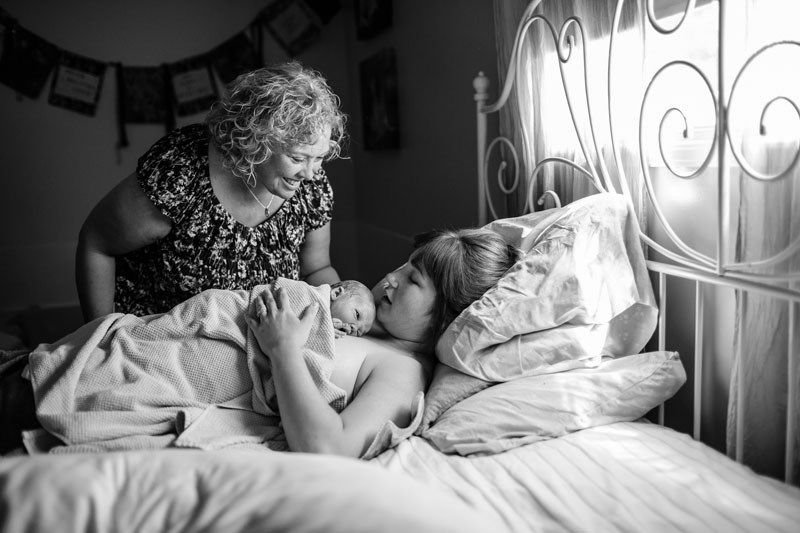Ten years ago Sabrina Roy had never really thought about using a midwife, let alone becoming one, but now she is helping to open St. Albert’s first midwifery practice and expand the service into rural areas.
The St. Albert Community Midwives clinic was founded by three former Lucina Midwives employees, Roy, Anna Gimpel and Jennifer Thompson, and began seeing clients earlier last month.
The practice was a direct result of new provincial funding announced in September.
When the province announced that it was increasing funding for midwife-supported births, St. Albert was identified as a high-demand area for a number of reasons: the high number of young families in the area, the fact that Sturgeon County Hospital performs low-risk deliveries and the lack of service in the north Edmonton area.
Since individual midwives are only legislated to assist 40 births per year – to maintain a healthy workload given they are on call 24/7 – and all three were replaced by midwives who were previously unable to find work, this means 120 more midwife-supported births for the area.
Also since midwives are required to keep their catchment area within a 45-minute radius, this expands the service further north and west into surrounding counties.
Roy had brought the lack of service in the area to the attention of the Alberta Association of Midwifery in the past, but at the time the province was not approving any new practices.
Despite the rapid growth of the profession – since 2009, when the province first started funding the service, the number of registered midwives has grown to 94 from 31 – rural and remote areas remain underserved.
“Historically the midwives in Alberta have been clustered along the QE2 corridor,” said Chad London, dean of the faculty of health, community and education studies at MRU.
Mount Royal University opened the province’s first, and only, midwifery education program in 2011. The school saw its first eight graduates cross the floor this June. Another 12 students are set to receive their degrees in summer 2016.
Serving the areas of St. Albert, Sturgeon and Parkland counties and Edmonton, the opening of a practice in St. Albert will help with shortages in rural areas, said London.
“If we can get out of city centres … we’re making headway in addressing the need for midwifery care in rural areas,” he said.
St. Albert Community Midwives becomes the eighth practice in the Edmonton area. There is one located in Stony Plain.
Midwives provide care throughout pregnancy, as well as during and up to six weeks after birth. They are experts in low-risk pregnancies.
Roy herself, engaged a midwife for the birth of all four of her children. The latest, Anja was delivered by her St. Albert Community Midwives colleague Gimpel.
Prior to her initial experience with midwifery, Roy said she held many misconceptions about the practice.
“I was in the similar situation as many women, where I just didn’t know what a midwife was. I had some idea, in terms of home birth and water birth. I had a vision of a very earthy looking woman playing the role of the midwife,” she recalls.
When she sat down for her first meeting she immediately felt the difference between midwifery and traditional physician care.
Served a cup of freshly brewed tea, Roy was asked about her family, her pregnancy, her wishes for the birth. The two discussed how to prepare for motherhood.
“It was about the whole experience, rather than how much do you weigh, pee in this cup, see you in a month,” she said, adding that she does not want to criticize doctors, but simply point out the difference between the practices.
Midwifery puts an emphasis on helping women make informed choices about childbearing and birth, letting women decide where they would like to give birth and providing continuity of care.
Maternity care in Alberta is currently under a lot of pressure, explained Roy. Many obstetricians are beginning to retire and doctors are overworked, making continuity of care very difficult.
“Some hospitals in the area work on a rotation with 10 doctors, so there’s actually a 1 in 10 chance of having the doctor that you’ve seen your whole pregnancy actually be the one who delivers your baby on the big day,” said Roy.
While there is still a chance that another midwife could deliver your baby, Alberta requires another midwife to be in attendance during labour as a secondary caregiver, so the likelihood that the person delivering your baby is known to you is high.
“Which is a bit of a warm and fuzzy idea,” admits Roy, “but it actually plays out in the research as leading to better health outcomes for the mother and the baby.”
Although she moved during her first pregnancy and therefore was unable to fully experience the benefits of continuity of care, Roy knew that she had stumbled upon her career path.
She received her midwifery degree from Laurentian University in 2009, and practised in Ontario for three years before moving to Edmonton and joining Lucina Midwives.
The clinic, located in the south of St. Albert, is currently accepting patients.
St. Albert Community Midwives offer in-hospital birthing support – they have admitting privileges in the Sturgeon Community Hospital – but give preference to women who wish to deliver at home or at a birthing centre since they can’t be accommodated by other health care providers.




